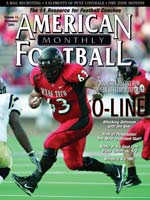AMERICAN FOOTBALL MONTHLY THE #1 RESOURCE FOR FOOTBALL COACHES
Article CategoriesAFM Magazine
|
Passing EfficiencyA complicated formula but a measure of successby: AFM Editorial Staff © More from this issue 10 IMPACT STATS TO BUILD A CHAMPIONSHIP TEAM #7 Pittsburgh Quarterback Ben Roethlisberger had a quarterback rating of 158.3 – the highest attainable by NFL standards – in the Steelers opening game of the season. He passed for 253 yards with 9 of 11 completions and without throwing an interception. The NFL’s formula for rating quarterbacks combines pass attempts and completions, percentages of completions and those intercepted as well as touchdown passes and – possibly the most important statistic in the formula – average number of yards per attempt. A rating of 100 is considered outstanding. The NCAA has a similar formula for teams in what is called Passing Efficiency. The following categories are included to determine a team’s PE: 1. Pass attempts 2. Pass completions ....The full article can only be seen by subscribers. Subscribe today!
|
|
|||||||
| HOME |
MAGAZINE |
SUBSCRIBE | ONLINE COLUMNISTS | COACHING VIDEOS |
Copyright 2025, AmericanFootballMonthly.com
All Rights Reserved





